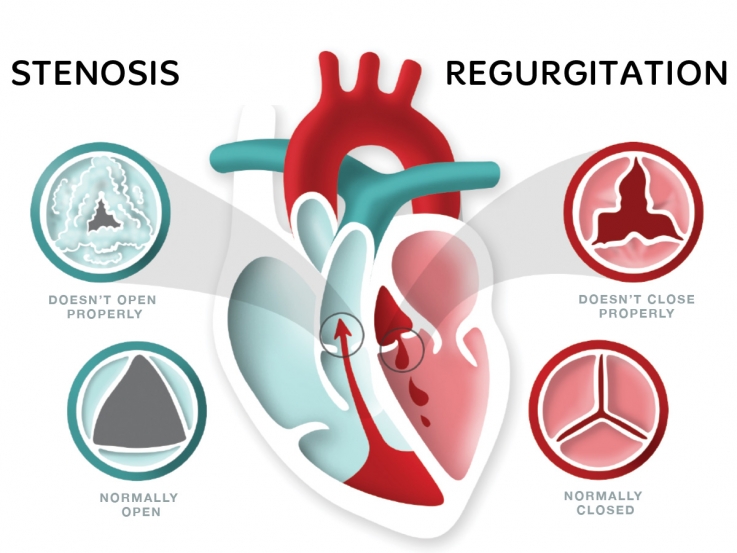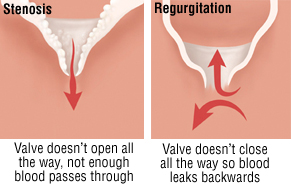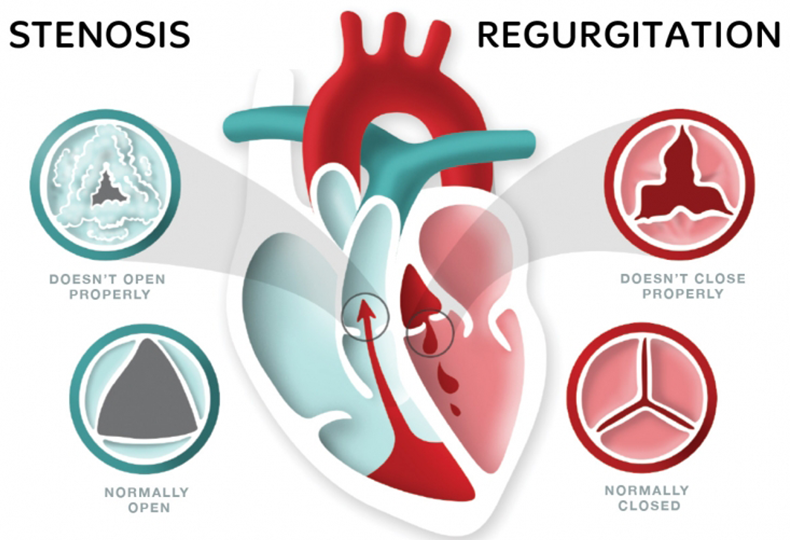【AS】How to Differentiate Between Aortic Valve Stenosis and Aortic Valve Regurgitation?
Aortic valve stenosis and aortic valve regurgitation are two common diseases of the aortic valve, both caused by functional problems of the aortic valve leaflets and have similar symptoms, which makes it difficult for many people to distinguish between these two diseases.
However, although both occurring at the small aortic valve orifice, valve stenosis and regurgitation have different pathogenesis as well as different impacts on the circulation of the cardiovascular system .

So, where do these differences specifically manifest?
Different Etiologies
The main cause of aortic valve stenosis is age-related progressive calcification (accounting for 50% of all cases), followed by congenital malformations of the aortic valve (30-40% of all cases) and rheumatic fever (less than 10% of all cases). A small number of cases of aortic valve stenosis are caused by factors such as radiation therapy, Fabry's disease, lupus erythematosus, and inflammation.
The common causes of aortic valve stenosis can also lead to aortic valve regurgitation, as structural abnormalities of the aortic valve caused by the progression of valve stenosis can also lead to the valve not closing properly.
In developed countries, the main cause of aortic valve regurgitation is dilation of the aortic root (valve annulus dilation) and some arterial diseases, such as cystic necrosis of the middle layer of the aortic valve annulus, dilation of the ascending aorta, aneurysm, and aortic dissection, all of which may cause aortic valve regurgitation.
In addition, osteogenesis imperfecta, aortic dissection, Behcet's disease, trauma, etc., may also cause aortic valve regurgitation; the use of certain drugs, such as fenfluramine, dexfenfluramine, and dopamine agonists, may also be associated with the occurrence of aortic valve regurgitation.
Different Pathogenic Processes
As the valve between the left ventricle and the aorta. the aortic valve is in a closed or open state corresponding to the diastole or systole of the ventricle, ensuring normal blood circulation in the heart. When aortic valve stenosis or aortic valve regurgitation occurs, the blood circulation abnormalities caused by the two conditions have significant differences.

Aortic valve stenosis refers to the narrowing of the valve opening, leading to reduced blood flow between the aorta and the ventricle, so that the heart and other parts of the body cannot obtain sufficient blood supply, which means that the mutual circulation ability between the heart and the aorta is weakened. In the early stage of aortic valve stenosis, the left ventricle will contract more forcefully to ensure that the body and heart receive a normal amount of blood, usually leading to left ventricular hypertrophy, ultimately reducing the efficiency of the heart.
Aortic valve regurgitation refers to the inability of the aortic valve to close properly during left ventricular diastole, causing some or even most of the blood ejected by the heart to flow back into the left ventricle. By the next systole, the heart needs to contract more forcefully to eject excess blood from the ventricle. Over time, aortic valve regurgitation can also lead to left ventricular hypertrophy.
As a result, aortic valve stenosis and aortic valve regurgitation have quite different pathogenic processes even if both lead to left ventricular hypertrophy. More vividly, left ventricular hypertrophy caused by aortic valve stenosis is due to the heart pumping harder to maintain normal blood flow, while left ventricular hypertrophy caused by aortic valve regurgitation is due to the heart increasing its contraction force to eject the leaked blood.
Different Symptoms
Aortic valve stenosis and aortic valve regurgitation are both typical chronic diseases, and patients can go for decades without symptoms. Because both diseases can cause left ventricular hypertrophy and myocardial ischemia, their symptoms of exertional symptoms are very similar, commonly including palpitations, dyspnea, angina pectoris, syncope, easy fatigue, decreased exercise tolerance, excessive sweating, etc. Both can also cause left or right heart failure in the late stages of the disease, followed by similar symptoms such as hypotension, haphalgesia, ankle edema, pleural effusion, ascites, cyanosis, orthopnoea, hepatomegaly, atrial fibrillation, paroxysmal nocturnal dyspnea, and pulmonary edema.
However, there are also many differences in spite of many similarities in symptoms between the two diseases. Generally speaking, the symptoms caused by aortic stenosis are more severe than those caused by aortic valve regurgitation.
A unique disease that can be caused by aortic valve stenosis is von Willebrand factor abnormality, which can lead to a tendency to bleed, including chronic gastrointestinal bleeding, dermatorrhagia, and mucosal hemorrhage. The most typical unique symptom of aortic valve regurgitation is an abnormally strong heartbeat sensation, especially when lying on the left side or prone, and patients often feel strong arterial pulsation sensations in various parts of the body, especially in the head and neck. Both aortic valve stenosis and regurgitation can cause embolism, but the former is more common than the latter. In addition, aortic valve stenosis may also lead to sudden death, but this is not common in patients with aortic valve regurgitation.
Aortic valve stenosis patients also need to be aware that taking some cardiovascular drugs may cause syncope or hypotension, including nitroglycerin, nitrates, ACE inhibitors, terazosin (Hytrin), and hydralazine, etc.If you have other cardiovascular diseases and need to use these medications, please proactively inform your attending physician of your medical history.
References:
[1] Schade R, Andersohn F, Suissa S, Haverkamp W, Garbe E (2007). Dopamine agonists and the risk of cardiac-valve regurgitation. N. Engl. J. Med. 356 (1): 29–38.














 沪公网安备 31011502014876号
沪公网安备 31011502014876号 are registered trademarks of MicroPort CardioFlow Medtech Corporation.
are registered trademarks of MicroPort CardioFlow Medtech Corporation.